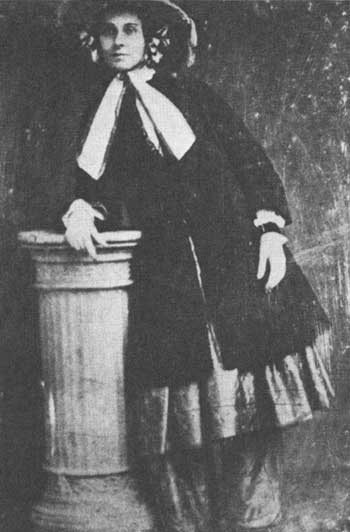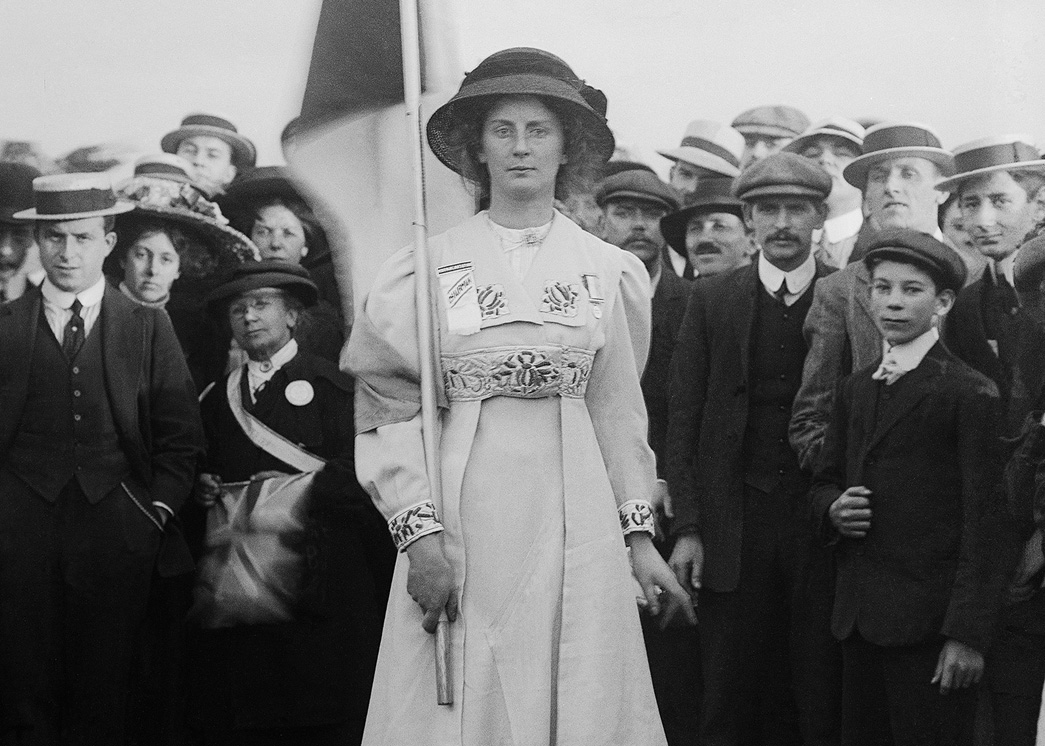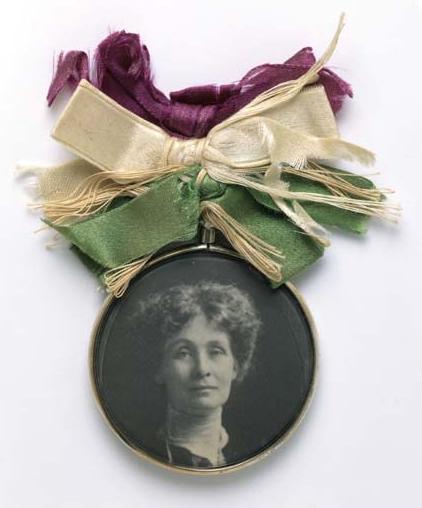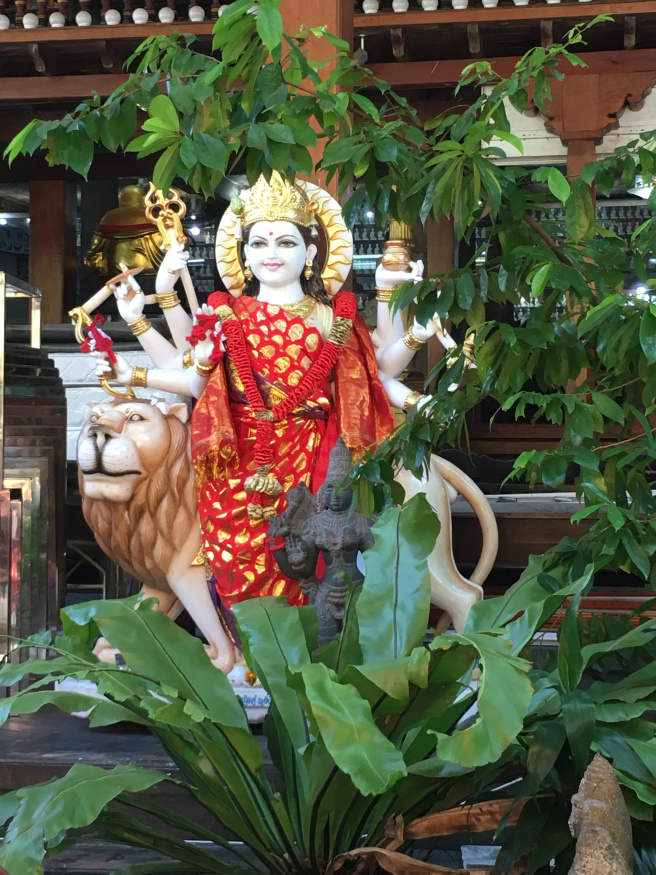1770’s – 1790’s The Homespun American Revolution
Women did not have the right to vote in the Revolutionary United States, but that doesn’t mean they were politically inactive. American women engaged in the politics of the day through politicizing traditionally female spaces, such as domestic clothing production. In order to prevent dependence on British imports and defy British imperial taxation, revolutionary women made homespun clothing.
The wearing of “homespun” became a symbol of the American Revolution. Homespun military uniforms clothed the revolutionaries. In this way, women became visible in the fight for independence.
Even fierce first Lady and women’s rights activist Abigail Adams made homespun clothing.
 Abigail Adams. Public Domain.
Abigail Adams. Public Domain.
Significantly, making homespun took place in female spaces. Like Harriet Hemenway saving the birds over tea, these women used their domestic social setting as a tool for political activism. Shelia Skemp argues that even though women did not gain rights with the American revolution, their identity as political actors and patriots changed: “Even post-war women who had no interest in politics defined themselves as members of the republic, as rights-bearing citizens who were proud to be patriotic actors.”[1]
 Spinning in an 18th-century home. Public Domain.
Spinning in an 18th-century home. Public Domain.
1840’s – 1850’s Amelia Bloomer Popularizes Pants
Amelia Bloomer edited the first American newspaper for women, called The Lily. She was the paper’s sole editor and owner. The heading of the paper ran “Devoted to the Interests of Woman.” Amelia underscored this in her first editorial, where she wrote that “It is woman that speaks through The Lily.“[2] And speak she would – Amelia’s editorial (and sartorial!) choices are still with us today.
Like many female activists of her time, Amelia was involved in the temperance movement before shifting her focus to women’s rights. She was frustrated by what she saw as women’s limited role in temperance societies. She lamented that women “could attend meetings and listen to the eloquence and arguments of men, and they could pay their money towards the support of temperance lecturers, but such a thing as their having anything to say or do further than this was not thought of.”[3] Through Amelia’s paper, she made sure that women had more to say and do – and wear.
 Amelia Bloomer in the “short dress” that would come to bear her name. National Park Service.
Amelia Bloomer in the “short dress” that would come to bear her name. National Park Service.
In the 1850’s, women’s dress reform was an activist issue, though an oft-ridiculed one. Women’s rights activists like Amelia Bloomer saw women’s dress as restrictive and degrading. Feminists in Seneca Falls, like Elizabeth Smith Miller and Elizabeth Cady Stanton, began wearing the “short dress” costume that they felt afforded them more freedom. After their example, Amelia published an engraving of herself wearing the outfit in The Lily.
The “short dress” was subject to immediate and widespread ridicule. But women were interested, and subscriptions to The Lily increased. Sensing the importance of dress reform, Amelia Bloomer would wear the outfit that would come to be named after her exclusively for the next eight years.
 1850’s caricature of women wearing bloomers. This cartoon associates the “short dress” with something that was considered equally unfeminine: smoking. Wikimedia Commons.
1850’s caricature of women wearing bloomers. This cartoon associates the “short dress” with something that was considered equally unfeminine: smoking. Wikimedia Commons.
Ultimately, many feminists did give up wearing “Bloomers” in order to focus on women’s rights issues and be taken seriously. Amelia Bloomer herself stopped wearing the outfit and wrote: “There were other questions of greater importance than the length of a skirt under discussion at the time, and I felt my influence would be greater in the dress ordinarily worn by women than in the one I was wearing.”[4] This is a historical case study where what you wore mattered, unfortunately, more than what you said.
1850’s – 1900’s Suffragettes Wore White (and Other Colors)
In Britain, women’s fight for the vote came to be associated with the tricolor: purple, white, and gold. The Suffragist, from December 6, 1913, outlines the symbolism of the colors: “Purple is the color of loyalty, constancy to purpose, unswerving steadfastness to a cause. White, the emblem of purity, symbolizes the quality of our purpose; and gold, the color of light and life, is as the torch that guides our purpose, pure and unswerving.”[5]
 Charlotte Marsh poses before a crowd assembled in Hyde Park. Museum of London.
Charlotte Marsh poses before a crowd assembled in Hyde Park. Museum of London.
In the above picture, Suffragette leader Charlotte Marsh wears white, symbolizing the women’s suffrage movement. She was the Colour Bearer for the Suffragette procession on June 18, 1910 in support of the Conciliation Bill. She also wore on her chest her hunger-strike medal, which commemorated her having endured force-feeding for three months while imprisoned. Women in white dresses came to be a visible sign of the movement.
White dresses spread across the globe. In Australia, purple, green, and white symbolized the women’s movement. The American suffrage movement also combined these colors. These colors were incorporated into jewelry, sashes, hats, and other wearable symbols of women’s fight for the vote.
 Portrait badge of Emmeline Pankhurts, suffragette. Wikimedia Commons.
Portrait badge of Emmeline Pankhurts, suffragette. Wikimedia Commons.
These are but three short examples from a limited scope of women’s history — women’s clothing has been politicized for centuries. Activists who combine what they say with what they wear are working in a rich tradition of women’s protest.
Featured Image: Public Domain
Sources:
- “Amelia Bloomer,” National Parks Service.
- “Amelia Bloomer,” National Women’s History Museum.
- “Amelia Bloomer: Publisher and Advocate for Women’s Rights.” Social Welfare Library.
- “Purple, Green, and White: An Australian History.” Museum of Applied Arts and Sciences.
- “How Suffragettes used fashion to further the cause.” The Guardian
- Hermanson, Tove. “Knitting as Dissent: Female Resistance in America Since the Revolutionary War.” Textile Society of America. DigitalCommons@Universityof Nebraska, 2012.
- Skemp, Sheila L. “Woman and Politics in the Era of the America Revolution.” Oxford Research Encyclopedia of American History, June 2016.
[1] Skemp, Sheila L. “Woman and Politics in the Era of the America Revolution.” Oxford Research Encyclopedia of American History, June 2016.
[2] “Amelia Bloomer,” National Parks Service.
[3] Ibid.
[4] As quoted in Social Welfare Library.
[5]LaCroix, Allison. “The National Women’s Party and the Meaning Behind Their Purple, White, and Gold Textiles.” National Women’s Party.
Share this:




